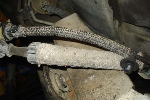trucku
Explorer Addict
- Joined
- January 25, 2005
- Messages
- 2,015
- Reaction score
- 5
- City, State
- Queens, New York and living in Budd Lake, NJ now.
- Year, Model & Trim Level
- 2002 Explorer XLS 4.0 4x4
AWD Viscous Coupling Fluid (4x4 to AWD swap)
I bought an AWD transfer case some months ago. I think it is a working case with no issues with the viscous coupler. I however have been reading and watching videos on YouTube about AWD viscous couplers. I recently watched a viscous coupler rebuild on YouTube. I believe that I have found the proper fluid used in the coupler. It is a Pure Silicone Fluid at 100,000 cSt (centistokes).
Video I was watching, not in English, just read the comments below.
I called a company that makes the same fluid in Philadelphia. The smallest amount sold is by the gallon. One gallon is $110.
If I can verify that this is the correct fluid and that the viscous coupler for my AWD transfer case can be rebuilt, I might just go ahead and buy the fluid. It is a lot cheaper than a new coupler. It might be advantageous for a number of members to do a group buy on this product for those who want to rebuild their viscous coupler.
If anyone can verify the info please do. I just wanted to put this out in case someone can help me confirm if this is the right fluid.
Thanks
Vishant
What is used in the video
Another link
In English here
I bought an AWD transfer case some months ago. I think it is a working case with no issues with the viscous coupler. I however have been reading and watching videos on YouTube about AWD viscous couplers. I recently watched a viscous coupler rebuild on YouTube. I believe that I have found the proper fluid used in the coupler. It is a Pure Silicone Fluid at 100,000 cSt (centistokes).
Video I was watching, not in English, just read the comments below.
I called a company that makes the same fluid in Philadelphia. The smallest amount sold is by the gallon. One gallon is $110.
If I can verify that this is the correct fluid and that the viscous coupler for my AWD transfer case can be rebuilt, I might just go ahead and buy the fluid. It is a lot cheaper than a new coupler. It might be advantageous for a number of members to do a group buy on this product for those who want to rebuild their viscous coupler.
If anyone can verify the info please do. I just wanted to put this out in case someone can help me confirm if this is the right fluid.
Thanks
Vishant
What is used in the video
Another link
In English here











